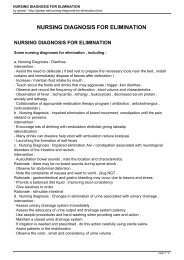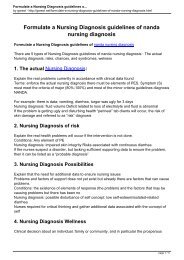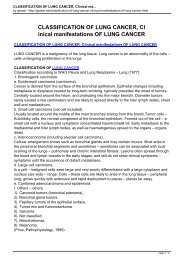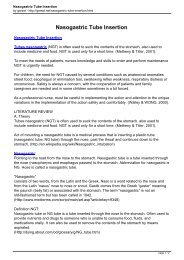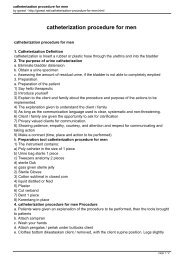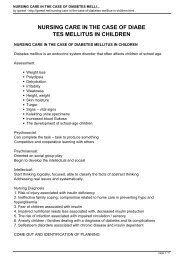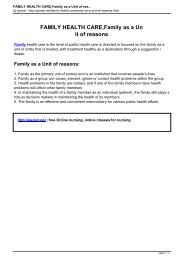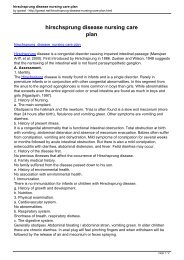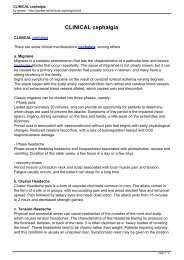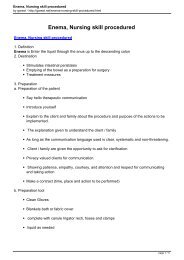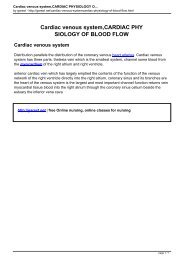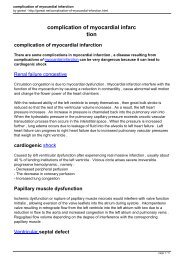Nursing assessment in stroke pati ents
You also want an ePaper? Increase the reach of your titles
YUMPU automatically turns print PDFs into web optimized ePapers that Google loves.
<strong>Nurs<strong>in</strong>g</strong> <strong>assessment</strong> <strong>in</strong> <strong>stroke</strong> <strong>pati</strong><strong>ents</strong><br />
by garest - http://garest.net/nurs<strong>in</strong>g-<strong>assessment</strong>-<strong>in</strong>-<strong>stroke</strong>-<strong>pati</strong><strong>ents</strong>.html<br />
<strong>Nurs<strong>in</strong>g</strong> <strong>assessment</strong> <strong>in</strong> <strong>stroke</strong> <strong>pati</strong><br />
<strong>ents</strong><br />
<strong>Nurs<strong>in</strong>g</strong> <strong>assessment</strong> <strong>in</strong> <strong>stroke</strong> <strong>pati</strong><strong>ents</strong><br />
Stroke or cerebrovascular <strong>in</strong>jury is a loss of bra<strong>in</strong> function caused by the cessation of blood<br />
supply to part of the bra<strong>in</strong> is often the culm<strong>in</strong>ation of cerebrovascular disease for several years.<br />
(Suzanne C. Smeltzer, 2002, p 2131)<br />
<strong>Nurs<strong>in</strong>g</strong> <strong>assessment</strong> <strong>in</strong> <strong>stroke</strong> <strong>pati</strong><strong>ents</strong><br />
1. Activity and rest<br />
Subjective Data:<br />
- Difficulties <strong>in</strong> the move; weakness, loss of sensation or paralysis.<br />
- Tiredness, trouble breaks (pa<strong>in</strong> or muscle spasms)<br />
Objective data:<br />
- Changes <strong>in</strong> the level of consciousness<br />
- Changes <strong>in</strong> muscle tone (flaccid or spastic), paraliysis (hemiplegia), general weakness.<br />
- Impaired vision<br />
2. Circulation<br />
Subjective Data:<br />
- History of heart disease (heart valve disease, dysrhythmias, heart failure, bacterial<br />
endocarditis), polycythemia.<br />
Objective data:<br />
- Arterial Hypertension<br />
- Dysrhythmias, ECG changes<br />
- Pulsation: the possibility of vary<strong>in</strong>g<br />
- Pulse carotid, femoral and iliac artery or abdom<strong>in</strong>al aorta<br />
3. Ego <strong>in</strong>tegrity<br />
Subjective Data:<br />
- Feel<strong>in</strong>gs of helplessness, despair<br />
Objective data:<br />
- Emotions are unstable and improper angry, sadness, joy<br />
- Difficulties to express themselves<br />
4. Elim<strong>in</strong>ation<br />
Subjective Data:<br />
- Incont<strong>in</strong>ence, anuria<br />
- Abdom<strong>in</strong>al distension (bladder is very full), the absence of bowel sounds (paralytic ileus)<br />
5. Eat<strong>in</strong>g / dr<strong>in</strong>k<strong>in</strong>g<br />
Subjective Data:<br />
- Appetite lost<br />
- Nausea / vomit<strong>in</strong>g <strong>in</strong>dicates PTIK<br />
- Loss of sensation of the tongue, cheeks, throat, dysphagia<br />
page 1 / 3
<strong>Nurs<strong>in</strong>g</strong> <strong>assessment</strong> <strong>in</strong> <strong>stroke</strong> <strong>pati</strong><strong>ents</strong><br />
by garest - http://garest.net/nurs<strong>in</strong>g-<strong>assessment</strong>-<strong>in</strong>-<strong>stroke</strong>-<strong>pati</strong><strong>ents</strong>.html<br />
- History of DM, Increased fat <strong>in</strong> the blood<br />
Objective data:<br />
- Problems <strong>in</strong> chew<strong>in</strong>g (decreased reflexes palate and pharynx)<br />
- Obesity (risk factors)<br />
6. Sensory neural<br />
Subjective Data:<br />
- Dizz<strong>in</strong>ess / syncope (prior CVA / TIA while over)<br />
- Headache: the <strong>in</strong>tra-cerebral hemorrhage or sub arachnoid hemorrhage.<br />
- Weakness, t<strong>in</strong>gl<strong>in</strong>g / numbness, affected side looks like a lame / off<br />
- Vision is reduced<br />
- Touch: loss of sensors on the collateral <strong>in</strong> the extremities and the face ipsilateral (same side)<br />
- Impaired sense of taste and smell<br />
Objective data:<br />
- Mental status; coma stage is usually marked bleed<strong>in</strong>g, behavioral disturbances (such as:<br />
letergi, apathy, attack) and impaired cognitive function<br />
- Extremity: weakness / paraliysis (contralateral to all types of <strong>stroke</strong>, uneven hand grip,<br />
reduced deep tendon reflexes (contralateral)<br />
- Face: paralysis / parese (ipsilateral)<br />
- Aphasia (damage to or loss of the function of language, expressive possibility / difficulty<br />
say<strong>in</strong>g the word, receptive / difficulty say<strong>in</strong>g the word comprehensive, global / comb<strong>in</strong>ation of<br />
both.<br />
- Loss of the ability to know or see, auditory, tactile stimuli<br />
- Apraxia: lose the ability to use motor<br />
- Reaction and pupil size: not dilated and did not react on the lateral side<br />
7. Pa<strong>in</strong> / comfort<br />
Subjective Data:<br />
- Headache vary<strong>in</strong>g <strong>in</strong>tensity<br />
Objective data:<br />
- Unstable behavior, anxiety, muscle tension / facial<br />
8. Respiration<br />
Subjective Data:<br />
- Smokers (risk factors)<br />
Signs:<br />
- Weakness swallow / cough / protect the airway<br />
- The emergence of difficult breath<strong>in</strong>g and / or irregular<br />
- Voice breath sounds ronchi / aspiration<br />
9.Keamanan<br />
Objective data:<br />
- Mottrik / sensory: problems with vision<br />
- Changes <strong>in</strong> the perception of the body, difficulty see<strong>in</strong>g objects, miss<strong>in</strong>g kewasadaan to the<br />
sick body<br />
- Not be<strong>in</strong>g able to recognize objects, colors, words, and faces never recognized<br />
- Disturbance respond to heat, cold and / disturbances <strong>in</strong> body temperature regulation<br />
- Disturbance <strong>in</strong> decid<strong>in</strong>g, little attention to security, reduced self-awareness<br />
10. Social <strong>in</strong>teractions<br />
Objective data:<br />
page 2 / 3
Powered by TCPDF (www.tcpdf.org)<br />
<strong>Nurs<strong>in</strong>g</strong> <strong>assessment</strong> <strong>in</strong> <strong>stroke</strong> <strong>pati</strong><strong>ents</strong><br />
by garest - http://garest.net/nurs<strong>in</strong>g-<strong>assessment</strong>-<strong>in</strong>-<strong>stroke</strong>-<strong>pati</strong><strong>ents</strong>.html<br />
- Problem speech, <strong>in</strong>ability to communicate<br />
11. Teach<strong>in</strong>g / learn<strong>in</strong>g<br />
Subjective Data:<br />
- A family history of hypertension, <strong>stroke</strong><br />
- The use of oral contraceptives<br />
12. Consideration home plan<br />
- Determ<strong>in</strong>e the medication regimen / therapy treatment<br />
- Assistance to transportation, shopp<strong>in</strong>g, meal preparation, personal care and domestic work<br />
(DoengesE, Marilynn, 2000 case 292)<br />
http://garest.net | free Onl<strong>in</strong>e nurs<strong>in</strong>g, onl<strong>in</strong>e classes for nurs<strong>in</strong>g<br />
page 3 / 3




